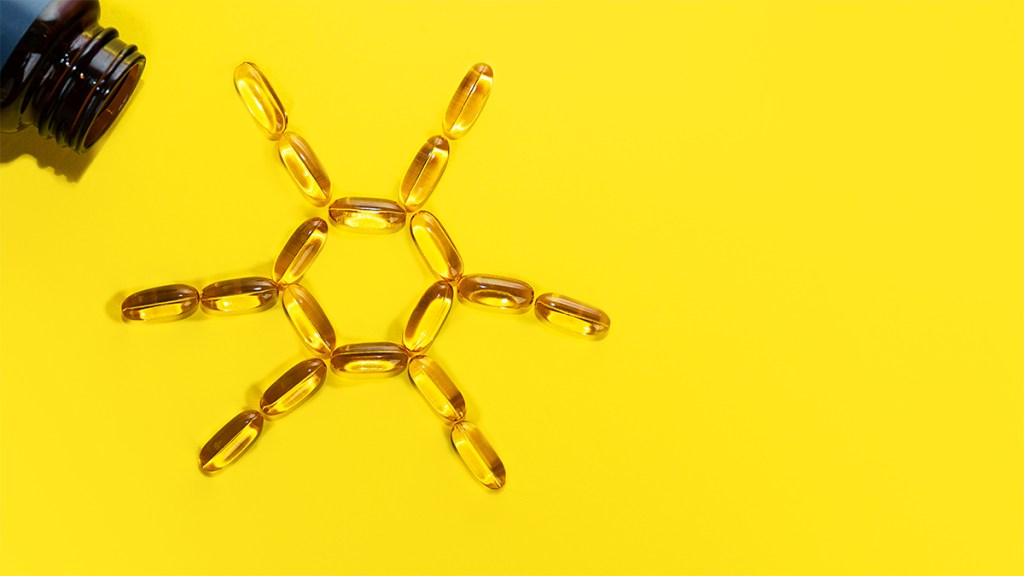If You Can’t Lose Weight, Suffer From Muscle Aches and Feel Blah, You Likely Need More Vitamin D, Say Doctors
New research shows we need 10x more than the government recommends for optimal metabolism

Running errands, wrestling with work deadlines, doing yardwork and household chores, tending to family and loved ones’ needs — we all have days that prove taxing and tiring. But when tiredness and out-and-out exhaustion become a constant burden, you could be suffering from a shortfall in vitamin D. You may be wondering, ‘How does vitamin D deficiency cause fatigue?’ The answer: The vitamin acts like a hormone in the body, optimizing organ function, brain and nerve cell communication, bone strength and more. So when the body’s supplies of vitamin D are low, feeling tired is almost a given. In fact, findings in the journal Medicine suggest that deficits in D lower energy levels by 76%.
Fortunately, reversing the drain is easy. Just ask Sylvia Owusu-Ansah, MD. She went from tired to terrific simply by lifting her vitamin D levels. And you can, too! Keep reading for information from top doctors on the link between vitamin D and tired, achy feelings, and how you can reverse the drain — naturally.
3 ways vitamin D protects against tiredness
Vitamin D has been dubbed the “sunshine vitamin” because it’s made naturally by the body when sunlight strikes skin. And while it was once known chiefly as a bone-builder, researchers now recognize it has a powerful ability to prevent — and even reverse — tiredness. Just some of the ways it works:
1. Vitamin D strengthens muscles = higher metabolism
By helping shunt calcium and phosphorus into bones, vitamin D protects against a bone-softening condition called osteomalacia. That’s crucial, since osteomalacia does more than weaken bones: As experts reporting in the Journal of Clinical medicine point out, this bone condition also triggers muscle weakness and fatigue.
Plus, findings in the Journal of Clinical Endocrinology and Metabolism reveal vitamin D strengthens muscles by revving energy-generating mitochondria in muscle cells. And in a study published in the Journal of Science Medicine and Sport, participants who optimized their levels of the vitamin increased their muscle strength by 32%. Increased muscle strength is associated with a lower likelihood of falling and increased metabolism. (Click through to learn how vitamin D stops age-related muscle loss to keep you active and independent for years to come.)
2. Vitamin D boosts thyroid function = greater energy
“Vitamin D is essential for thyroid function,” notes Richard L. Shames, M.D., author of Thyroid Power and creator of ThyroidPower.com. “It has to be present at sufficient levels for thyroid hormone to do its energizing work.” Indeed, researchers reporting in BMC Endocrinology determined that ample D stores lowered odds of suffering from thyroid slowdowns by 41%.
The reason, explains functional medicine expert Mark Hyman, MD: “For thyroid hormone T3, which is your master metabolism hormone, to work, it has to bind to cellular receptors in the body. Vitamin D primes those receptors.” So when D levels are ideal, the thyroid’s beneficial effects are enhanced. As a result, we enjoy greater energy and brighter moods. “Women are often shocked at how fantastic ‘normal’ can feel,” Dr. Hyman notes. (Click through to learn how vitamin D boosts production of DHEA, the “fountain of youth” hormone, and to learn how vitamin D can rev energy if you fall asleep after eating.)
3. Vitamin D lifts testosterone = lower risk of depression
Despite its reputation as a male hormone, testosterone plays crucial roles in female brain function, mood regulation and more. In fact, holistic gynecologist Shawn Tassone, MD, PhD, author of The Hormone Balance Bible, says, “At least 90% of women I see in my clinic suffer from fatigue and other draining symptoms due to low testosterone.” Fortunately, vitamin D has can increase production of the hormone in the ovaries and adrenal glands. In a Journal of Clinical Endocrinology & Metabolism study, healthy stores of vitamin D raised women’s testosterone levels by 48%. A recent meta-analysis of eight peer-reviewed studies found a significant association between depression in women and low testosterone levels.
Why so many women are deficient in vitamin D
“I can count on one hand how many of my patients had adequate vitamin D levels when I tested them,” says Susan Blum, MD, assistant clinical professor at Mount Sinai’s Icahn School of Medicine. Indeed, research conducted at Columbia University suggests up to 90% of women have suboptimal D levels. Here’s 4 reasons why:
1. Modern-day diets lack vitamin D
The Institute of Medicine (IOM) recommends that women get 600 IU of vitamin D from their diets each day. (See below for details on the best food sources.) But women’s diets don’t keep their vitamin D bases covered. In fact, USDA data indicates 97% of women get less than 400 IU from food and beverages daily.
What’s more, many experts say the IOM’s recommendations are woefully low. According to researchers reporting in the journal Nutrients, we should be getting 7,000 IU of vitamin D from our diets each day.
2. Vitamin D levels in the body drop with age
As mentioned earlier, sun-exposed skin makes vitamin D naturally. But as we age, the process becomes less efficient. In fact, authors of a Journal of Clinical Investigations study determined skin’s capacity to produce vitamin D decreases by 40% between our 20s and our 50s.
Another reason women over 50 are at increased risk increased risk of vitamin D deficits: “They’re more likely to stay out of the sun or wear a hat and sunscreen,” says Dr. Blum. And as a result they don’t absorb enough UV rays to make D.
Plus, pounds that creep on as the years go by can deprive the body of vitamin D, notes rheumatologist James Dowd, MD, author of The Vitamin D Cure. “D is a fat-soluble vitamin, so it’s sequestered in stored fat and not available to be used,” he explains.
3. Dark skin heightens odds of suffering from D deficiency
“Melanin, the pigment responsible for darker skin, is a natural sunscreen,” adds Dr. Dowd. “But when darker-skinned people are not outside as much and not near the equator, they can have startlingly low D levels. The proof: An analysis of CDC data published in the journal Nutrition Research determined having dark skin doubles the risk of vitamin D deficiency.
4. Genetic variations can also deprive women of vitamin D
An estimated 50% of women harbor a variation in the MTHFR gene, say scientists reporting in the American Journal of Human Genetics. That’s a cause for concern, since findings in the journal Human Reproduction reveal women with the variation have significantly lower levels. Experts explain the genetic variant lowers methylation, a process that converts vitamin D into its active form. (Click through to learn how a vitamin D deficiency causes hair loss, too, and how to reverse a shortfall to spark new growth.)
How to tell if a vitamin D deficiency is causing fatigue
If you’re experiencing red flags like fatigue, depression and muscle weakness, your doctor can ID vitamin D deficiency with tests that measure blood levels of 25-hydroxy vitamin D. Or you can try home tests like the at-home vitamin D test from Everlywell (Buy at Everlywell, $49) and the vitamin D test at Letsgetchecked.com (Buy at letsgetchecked, $89). The good news: If you’re D-depleted, the following strategies can shore up stores to restore energy.
4 ways to boost vitamin D levels
1. Soak up rays on sunny days
The skin produces vitamin D when it’s exposed to the sun’s rays. That’s the reason a BMC Public Health study found vitamin D deficiencies were 800% more common during dim winter months. But when sunny weather beckons, help is at hand: Experts reporting in the New England of Journal of Medicine say exposing your arms and legs to 15 minutes of midday sunshine before applying sunscreen supplies 3000 IU of vitamin D.
2. Take a vitamin D3 supplement each day
Supplementing with vitamin D3 (also known as cholecalciferol, a form of the vitamin that’s readily used by the body) is key to correcting deficiency. “My rule is to take 20 IU per pound of body weight per day,” says Dr. Dowd (that’s 4,000 IU for a 200-pound woman). “And for women with darker skin, 25 IU per pound per day.”

Also smart, according to Dr. Shames: Opt for an oil-based capsule. Because vitamin D is fat-soluble, the body absorbs it better when it’s accompanied by fat. In fact, a study in the journal Molecular Nutrition & Food Research found D capsules containing oil lifted levels of the vitamin 47% more than tablets did. One to try: Gundry MD Vitamin D 5000 (Buy on GundryMD, $24.95 for 90 softgels).
3. Fill up on foods that supply vitamin D
Though it’s admittedly hard to get ample D through diet alone, you can increase your levels by eating foods high in the vitamin. Some of the best options: fatty fish such as salmon, tuna mackerel and sardines, as well as fortified plant and dairy milks, cereals and orange juice.

Mushrooms also supply vitamin D — and they contain ergosterol, a compound that’s converted into D when exposed to sunshine. In fact, in a study published in Nutrition & Food Sciences, investigators found that when sliced mushrooms sat in sunlight, their D levels increased as much as 100%. Nutrition experts Mira Calton, CN, and Jayson Calton, PhD, advise the following: Simply slice mushrooms, arrange in a single layer on a tray. Then place the tray in a window that gets direct sunlight for six to eight hours. (If this dries them out, you can rehydrate them, if needed, by soaking them in water.)
4. Get more magnesium
In an American Journal of Clinical Nutrition study, folks who increased their magnesium intakes by about 200 mg per day lifted their vitamin D levels by up to 839%. Turns out the mineral activates enzymes that enhance the body’s ability to metabolize D. To get the boosting benefits, Dr. Shames advises enjoying magnesium-rich foods such as nuts, seeds and leafy greens daily. (Click through for more on the health benefits of magnesium, and which type is best: magnesium glycinate vs. citrate.)
Vitamin D success story: Sylvia Owusu-Ansah, MD

“Why do I feel this bad every morning?” worried Sylvia Owusu-Ansah, MD, as soon as she opened her eyes. “Lately, my body seemed so drained and stiff — even after a full night of sleep — that climbing out of bed required a multistep process. First, I’d sit up, then swing my feet to the side. And finally, I’d slide off the mattress and onto my feet. Something is really wrong, I thought. I’m like the Tin Man from ‘The Wizard of Oz,’ desperately in need of an oil can!
Sylvia was tired , foggy and moody
“For months, I hadn’t felt like myself. I suffered from zero energy, cloudy thinking, achy joints and cramping muscles. As an emergency room pediatrician, my patients kept me on my toes, but fatigue made me feel like I was 100 years old. I was also at the mercy of my moods, which were up and down, but mostly down. That was unusual for me because I knew I wasn’t depressed.
“I wanted to be proactive, so I started troubleshooting diagnoses. I had a history of anemia, but my iron levels were fine. I also wondered whether hormones could be behind my fatigue: I’d been diagnosed with a thyroid condition, but I was managing it well, so that seemed like another dead end. Maybe it’s just stress from juggling work and motherhood, I reasoned. Emergency room docs don’t get enough sleep anyway.
“As my symptoms continued, I grew more concerned. I knew I couldn’t suffer like this forever. In my job, I got exposed to more germs than a kindergarten teacher, and I didn’t want my health to unravel even more by developing extra sinus infections, colds or the flu while I was already running on empty.
Then Sylvia asked: does vitamin D deficiency cause fatigue?
“One day, I was hobbling through the hospital hallway like the robot C-3PO from Star Wars, when I was hit by my usual wall of afternoon fatigue. I had no choice but to put my head down on a desk and rest for a bit. That’s when an older nurse looked at me and said, ‘You better get your vitamin D checked.’
“Caught off guard, I responded, ‘What are you talking about?’ This wise nurse — who hailed from the Caribbean — explained, ‘It happened to me. It’s common for people like us with dark skin.’
“Sure enough, when I visited my endocrinologist, I had my levels checked and the results were shocking the results were: I was extremely deficient in vitamin D. The normal range is between 30 and 100, and I was only at 9! No wonder I feel like a sloth! I thought.
Restoring vitamin D levels restored Sylvia’s health
“Finally aware of what needed to be addressed, I started making changes. I knew there were different forms of vitamin D, which you can get from the sun and from nutrition. I also learned that African Americans are at a greater risk for this type of insufficiency because the higher levels of melanin, the dark pigment in our skin, reduce our body’s ability to produce vitamin D. I guess I took it for granted that I was getting enough sun, but clearly I wasn’t. To start healing, I made sure to spend a couple of hours each day in sunlight, while protecting myself from UV rays.
“I also added more vitamin D–rich foods into my diet, such as oily fish, egg yolks, portobello mushrooms, orange juice and fortified cereals. Knowing many African Americans are lactose intolerant, I was glad to see lots of fortified dairy alternatives too, like soy milk and yogurt. And since my levels were so low, I also supplemented with a high dose of D — 10,000 IU daily.
“Within two weeks of making these changes, I noticed a huge improvement in my health. My joints didn’t hurt, and my body felt spry. My thinking was clear — I could multitask again. Plus, my naps and mood swings were history! When I told the nurse she was right, she quipped, ‘See, I told ya.’ After a few months, I was able to drop down to a lower dosage of 2,000 IU, taken before my largest meal of the day for ideal absorption. My efforts were working because I was able to raise my vitamin D levels from 9 to 40 in just six months!
“This eye-opening diagnosis impacted the way I practice medicine. For healthcare professionals, vitamin deficiencies are often not at the top of our list when screening patients. But now it’s always on my radar, especially for people of color.
“Thankfully, it’s easy to overcome a vitamin D deficiency. Now, I feel an overwhelming sense of wellness. I have energy to care for my patients and my own children, plus walk 10 miles a week for exercise. I feel amazing. I’m exactly where I should be!”
This article originally appeared in our print magazine, First For Women.
This content is not a substitute for professional medical advice or diagnosis. Always consult your physician before pursuing any treatment plan.
For more on nutrients that can boost your energy, keep reading:
“I’m a Doctor and These Are the Daily Vitamins I Recommend for Women”



















